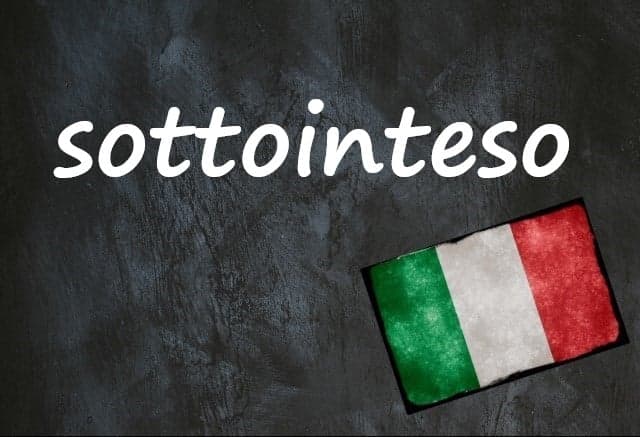
Italian word of the day: 'Sottointeso'

Wondering what the point of this Italian word is? Let us make it clear.
Today’s word is not simply a word, but a very Italian way of communicating.
Let’s get straight to the point: if you say something è sottointeso, in English this could be translated as ‘insinuated’ or ‘implied’, and it’s used to describe a way of speaking or writing in which you don’t come right out and say what you mean, but expect the other person to figure it out for themselves.
Sottointeso (sometimes spelled sottinteso) is made up of the Italian words sotto (under) and inteso (intended), and you could say this word is used to talk about the meaning beneath a message.
The dictionary defines this as concepts or thoughts "not explicitly expressed, but implicit and more or less easy to deduce."
This sounds like a pretty abstract concept, but it’s something anyone intent on learning Italian needs to be aware of if they want to fully understand what's going on. That’s because, unlike in English, you’ll find this type of allusion or indirectness is very common in everyday speech and writing.
- parlare a sottintesi
- to speak in innuendo
On one level, there’s the Italian neighbour who specialises in dropping what I’d call backhanded compliments or veiled insults (usually connected to the state of my windows, garden, hair, or all three) into conversations which seem friendly on the surface, leaving me oblivious to her intended meaning until it dawns on me much later.
Then there's the formal work or bureaucracy-related emails in Italian which read like a stream of consciousness peppered with lines from a legal textbook.
Even more baffling is the fact that such messages are not the result of someone having an extraordinarily bad day: they were written like that on purpose.
In fact, sottointeso communication is viewed as something of an art form, or the gold standard of writing excellence.
If you read a lot of Italian newspapers and magazines, you’ll know that you can find yourself reading all the way through a long article without ever discovering what point the writer is trying to make - and not because you don't understand Italian.
Such long-windedness is employed in almost every form of written communication, apparently to demonstrate the writer's mastery of the language and general cleverness.
The idea of writing or speaking in riddles, and therefore leaving what you say wide open to interpretation (and plausible denial), as being a particularly sophisticated and skilful way to communicate is not uniquely Italian, though.
In her book The Culture Map, intercultural communication expert Erin Meyer writes that speaking ‘sous-entendu’ - the French equivalent of sottointeso - is perceived as very good communication indeed by the French, who are very similar to Italians in this way. This, she says, is because what is seen as ‘good’ communication varies between cultures.
Anglophones, the experts say, tend to value clear and concise communication and instead find long-winded messaging frustrating and inarticulate. This is certainly true for me.
So if you find that many of the Italian speakers you meet have a tendency to use a lot of words to make a simple point, or often avoid saying things directly, this theory could explain why.
Either way, being aware that there’s a good chance the message is sottointeso is always helpful when trying to decode anything in Italy - from magazine articles to barbed comments from your neighbours.
Do you have a favourite Italian word you’d like us to feature? If so, please email us with your suggestion.
Comments (1)
See Also
Today’s word is not simply a word, but a very Italian way of communicating.
Let’s get straight to the point: if you say something è sottointeso, in English this could be translated as ‘insinuated’ or ‘implied’, and it’s used to describe a way of speaking or writing in which you don’t come right out and say what you mean, but expect the other person to figure it out for themselves.
Sottointeso (sometimes spelled sottinteso) is made up of the Italian words sotto (under) and inteso (intended), and you could say this word is used to talk about the meaning beneath a message.
The dictionary defines this as concepts or thoughts "not explicitly expressed, but implicit and more or less easy to deduce."
This sounds like a pretty abstract concept, but it’s something anyone intent on learning Italian needs to be aware of if they want to fully understand what's going on. That’s because, unlike in English, you’ll find this type of allusion or indirectness is very common in everyday speech and writing.
- parlare a sottintesi
- to speak in innuendo
On one level, there’s the Italian neighbour who specialises in dropping what I’d call backhanded compliments or veiled insults (usually connected to the state of my windows, garden, hair, or all three) into conversations which seem friendly on the surface, leaving me oblivious to her intended meaning until it dawns on me much later.
Then there's the formal work or bureaucracy-related emails in Italian which read like a stream of consciousness peppered with lines from a legal textbook.
Even more baffling is the fact that such messages are not the result of someone having an extraordinarily bad day: they were written like that on purpose.
In fact, sottointeso communication is viewed as something of an art form, or the gold standard of writing excellence.
If you read a lot of Italian newspapers and magazines, you’ll know that you can find yourself reading all the way through a long article without ever discovering what point the writer is trying to make - and not because you don't understand Italian.
Such long-windedness is employed in almost every form of written communication, apparently to demonstrate the writer's mastery of the language and general cleverness.
The idea of writing or speaking in riddles, and therefore leaving what you say wide open to interpretation (and plausible denial), as being a particularly sophisticated and skilful way to communicate is not uniquely Italian, though.
In her book The Culture Map, intercultural communication expert Erin Meyer writes that speaking ‘sous-entendu’ - the French equivalent of sottointeso - is perceived as very good communication indeed by the French, who are very similar to Italians in this way. This, she says, is because what is seen as ‘good’ communication varies between cultures.
Anglophones, the experts say, tend to value clear and concise communication and instead find long-winded messaging frustrating and inarticulate. This is certainly true for me.
So if you find that many of the Italian speakers you meet have a tendency to use a lot of words to make a simple point, or often avoid saying things directly, this theory could explain why.
Either way, being aware that there’s a good chance the message is sottointeso is always helpful when trying to decode anything in Italy - from magazine articles to barbed comments from your neighbours.
Do you have a favourite Italian word you’d like us to feature? If so, please email us with your suggestion.
Join the conversation in our comments section below. Share your own views and experience and if you have a question or suggestion for our journalists then email us at [email protected].
Please keep comments civil, constructive and on topic – and make sure to read our terms of use before getting involved.
Please log in here to leave a comment.